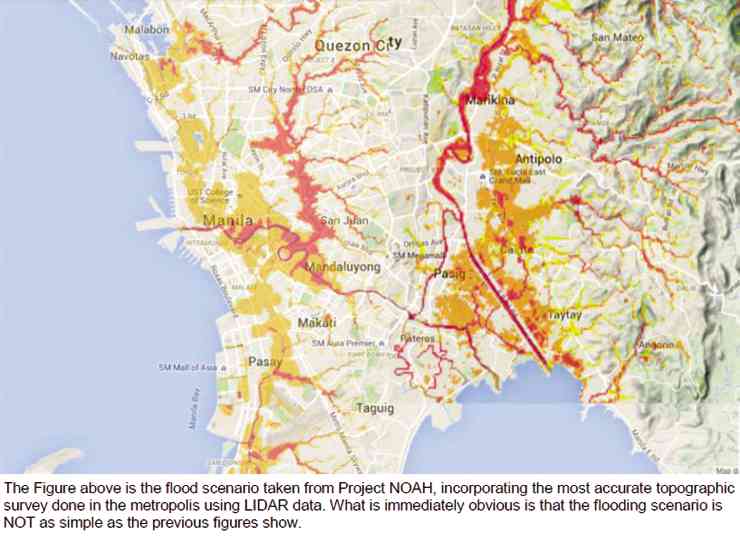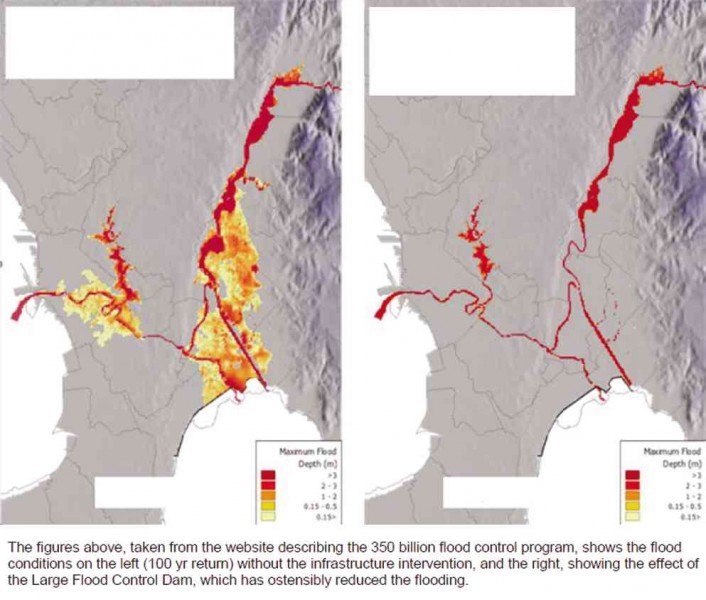P350-B flood control project flawed
IMPORTANT concerns need to be addressed regarding the P350-billion Metro Manila Flood Control Plan that the National Economic and Development Authority (Neda) has approved.
If these concerns are not addressed in a transparent and scientific manner, one must question the motives for pushing through a project that is lacking in scientific preparation. It will probably not work as designed and will probably be a vehicle for huge corruption.
Any flood control plan is only as good as the quality of the topographic data used in the modeling and planning. We thus ask: “Are current Manila flooding plans based on the most accurate topography data?” If not, we risk wasting billions of pesos. (See Figures 1 and 2.)
Figure 1 shows the flood conditions (100-year return) without the infrastructure intervention, while Figure 2 shows the effect of the large flood control dam, which has ostensibly reduced the flooding.
The figures were taken from the website describing the P350-billion flood control program.
Many details missing
What is wrong with Figures 1 and 2? Many details are missing, suggesting that the planning was not thorough. For example, flooding coming from the San Juan River, which has its own watershed, is not considered, among many other things.
Compare this with the Project Noah (National Operational Assessment of Hazards) flooding scenario in Figure 3, which incorporates the most accurate topographic survey done in the metropolis using Lidar (light detection and ranging) data. What is immediately obvious is that the flooding scenario is not as simple as the previous figures show.
Substandard flood model
The following implications are obvious:
The proposed large dam flood control program is not designed properly because the flood model it is using is obviously substandard.
This means that the infrastructure that will be done will not address sufficiently and properly the flooding. Why was the plan budgeted with a poor flood model? If the flood model basis is wrong, then how was the P350-billion estimate done?
Note that with a more accurate flood model, the interventions can be focused so that only the most threatened areas are addressed.
Lidar data for Metro Manila, which are the most accurate, have been available only the past two years and already used by Noah for flood projections. It does not take a rocket scientist to figure out that the Noah projections are much more accurate.

WHAT is immediately obvious is that the flooding scenario is not as simple as the previous figures show.
World Bank request
To top this all, Project Noah recently received a letter from the World Bank asking it to provide only now the flood projections it has made. This after the P350-billion project was approved by Neda.
Excerpts from a letter dated Oct. 8, from a World Bank officer:
Philippines: Metro Manila Flood Management Phase-1 Project
The World Bank is providing assistance to the Department of Public Works and Highways
(DPWH) and the Metropolitan Manila Development Authority (MMDA) toward the preparation of the Metro Manila Flood Management Phase-1 Project. The proposed project aims to address urban flooding in critical catchments as part of the long-term Metro Manila Flood Management Master Plan that was approved by the Neda Board in September 2012.
As part of project preparation, DPWH, MMDA and the Bank are studying flooding risks to come up with the most effective strategies for each drainage area. In view of this, we would like to request a copy of Project Noah data on flood risks. We would like to specifically request the shape files of the flood maps for the various return periods as shown in the Project Noah website. DOST and Project Noah will be appropriately cited. Our water specialist, Mr. _______ will be coordinating with you regarding our request.
Your assistance would be much appreciated.
Loan
This looks like the P350-billion project will be taken out as a loan, to be paid by the Filipino people. This is too much money to be spent when the details available now show that at best the plans are not based on the best data available.
How much has the Japan International Cooperation Agency (Jica), MMDA and DPWH spent the past many years for flood control efforts? Have these been vetted?
In contrast, Project Noah is barely 3 years old and has already made enormous impact on disaster prediction, with its results verified with actual data. Can the same be said of the numerous flood control projects designed under Jica?
Street flooding in the metropolis after short but intense rainfall can cause havoc in terms of flooding, traffic and disrupted lives. Work at the University of the Philippines National Institute of Geological Sciences and Project Noah, using detailed Lidar data, can predict localized flooding due to short-duration intense rainfall.
The immediate consequence of this is that engineering intervention (e.g., digging of flood reservoirs) can be focused only on affected areas, which should reduce costs significantly. Are the present DPWH-Jica plans equipped to do this and do it cost effectively?
Montalban watershed
We cannot overemphasize the importance of extreme rainfall modeling and the fact that most of the water flowing into Metro Manila originates from the Montalban watershed, and the only exit from Laguna de Bay to the sea is the relatively very small Pasig River.
Any flood control program looking only at Laguna de Bay will be myopic and will be very difficult to implement.
The bulk of this flood control program, a P200-billion dam in the Montalban area, may not be able to accommodate upstream river excess discharge.
Thus, any comprehensive flood control plan in this area must include a way to reduce extreme rainfall-related river discharge flowing into the Marikina River, which is the greatest source of discharge into the Laguna de Bay.
If flood measures are constructed only at the lowest elevations (i.e. Metro Manila and Laguna de Bay), this will probably not work, especially with massive, extreme rainfall events like Tropical Storm “Ondoy” in 2009 and the “habagat” flooding event in 2012.
Large dams, active faults
Flood control plans that will involve large dams in the Montalban watershed should also consider the existence of active faults in the area and the very large watershed areas that will be flooded to accommodate the dam water.
In the Marikina-Montalban watershed, the possibility of capture tunnels to reduce the discharge of floodwater flowing into Marikina and returning the captured water volume to the Sierra Madre divide for discharge eventually to the Pacific Ocean should be studied carefully.
Cheaper solution
This solution should be cheaper and could be integrated in the overall scheme of flood water management, resulting in a much lesser discharge of floodwater into the metropolis, which would reduce the kind and amount of intervention.
These capture tunnels might be more feasible than a proposed solution of making a channel from the Marikina Valley directly to the Manila Bay, potentially running over infrastructure and residents.
Camanava subsidence
An example of probably erroneous models—Japanese Jica/DPWH models in Camanava (Caloocan, Malabon, Navotas and Valenzuela)—did not consider subsidence in spite of plenty of evidence, rendering flood control projects there compromised from the beginning.
Dredging and large-ticket flood control items have been vehicles for huge corruption.
President Aquino was justified in canceling the P19-billion Laguna de Bay dredging contract which, not only was technically flawed, but also would not have served to control flooding in the metropolis.
Modus operandi
Even if the republic was sued because the contract was already fraudulently signed during the Arroyo administration, this reveals the criminal modus operandi of crafting billion-peso projects, using foreign consultants to justify the padded and substandard designs, and financing the projects with sovereign loans that the Filipino people will be paying in the long term.
This is probably the reason why Mr. Aquino mentioned in his State of the Nation Address that large-ticket items must be vetted and that competent Filipino engineers and scientists at least comment on the technical feasibility studies and do the requisite modeling before money is borrowed and spent.
Arbitration case
My testimony at the Philippine Republic vs Baggerwerken trial in Washington (international arbitration case in the World Bank, 2014) regarding the fraudulent P8-billion Pasig dredging project and the proposed P18-billion Laguna de Bay dredging project showed that very little technical vetting was done.
The testimony was considered crucial by both the Philippine and American lawyers for the Philippine position.
We discovered that the Laguna de Bay and Pasig dredging projects were not properly vetted technically even if these were endorsed by the DPWH, Department of Environment and Natural Resources and, especially Neda. The Philippine position was weakened because the lack of vetting was probably intentionally done to promote corruption.
Lesson
A most important lesson learned from the Washington trial is that these cases are best avoided by doing the technical vetting beforehand—before contracts and notices to proceed are signed and implemented. It is always more difficult to chase corrupt culprits after contracts are signed and “completed.”
Despite the best intentions, Neda does not have the wherewithal to do thorough technical vetting, especially for large-ticket projects.
We should end this rapacious cycle of creating substandard projects to be funded by sovereign loans from foreign banks that bring their own consultants who will not be looking out for genuine Philippine interests.
There are enough competent Filipino engineers and scientists who are honest and patriotic. They should help vet these projects and help stop this great corrupt leakage of funds that could have been used otherwise to build more classrooms, and other really needed and worthy infrastructure.
(Carlo A. Arcilla, MSc and Ph.D. [Geotechnical Engineering and Geosciences, University of Illinois] is a professor at and director of the National Institute of Geological Sciences, University of the Philippines Diliman. He can be reached at caloy.arcilla@gmail.com.)





















